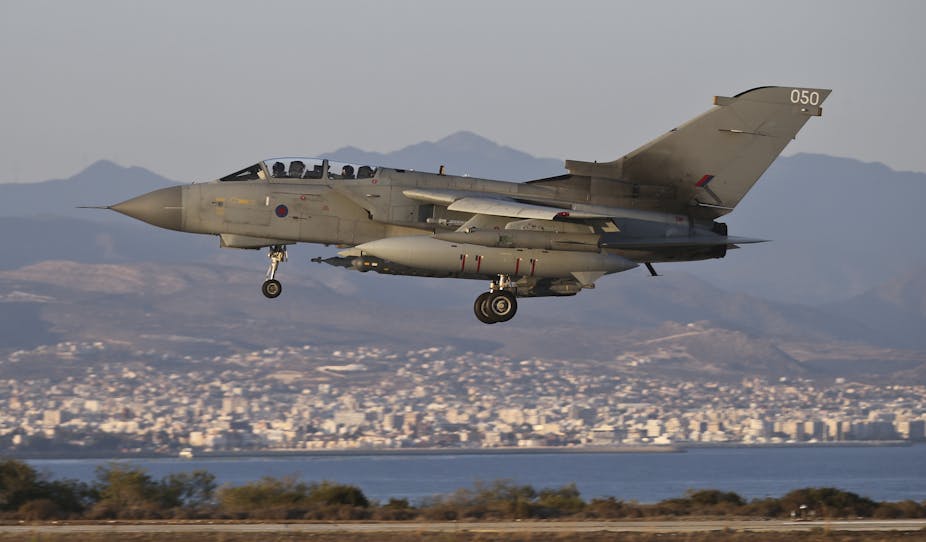The UK’s air assault on Islamic State (IS) began with two RAF Tornado GR4 bombers attacking targets in Iraq: one using a Paveway IV precision-guided munition (PGM) to destroy an IS heavy weapon position that was engaging Kurdish forces, the other firing a Brimstone missile at an armed pick-up truck.
After the two Gulf Wars, the intervening no-fly zone operations, and the lengthy operations in Afghanistan, this sort of language is familiar to anyone with a basic interest in international affairs.
But what does it mean – and what equipment is actually being deployed to execute these missions?
Leaner and meaner
Originally deployed on Harrier jets in Afghanistan, the Paveway IV PGM is an almost entirely different weapon to the Paveway II used in the first Gulf War on the Tornado and Buccaneer. Using GPS guidance, the Paveway IV can be programmed with target data from the Tornado’s own sensors or from a third party, such as a Forward Air Controller (FAC) on the ground.
It also retains the ability to home on a laser signal, from an airborne or ground designator. Being much more accurate than earlier PGMs it has a smaller, lighter, warhead which in turn reduces the likelihood of collateral damage.
Meanwhile, though initially envisaged as a Cold War anti-armour weapon, the Brimstone missile was subsequently equipped with a laser sensor in addition to its original basic radar one. With the ability to function in poor weather or at night, this is a very potent weapon against IS’s tanks, self-propelled artillery, and ubiquitous armed pick-up trucks.
Tornado force
The Tornado, which came into service in the early 1980s, is a twin-engined bomber, crewed by a pilot and a weapons systems officer. It was originally designed to attack Soviet and Warsaw Pact targets in the event of the Cold War hotting up.
It was later upgraded to GR4 standard, giving it a much better navigation system with integrated GPS and the ability to carry a range of new sensors, targeting on-the-ground devices and weapons.
Although designed to operate at very low level (200 ft or less), like all the coalition’s fast jets, it usually operates at medium altitudes (15-to-25,000 feet) to stay above anti-aircraft artillery and hand-held missile threat envelopes. At these altitudes and with air-to-air refuelling, missions can last between six to eight hours or longer.
The six Tornados at RAF Akrotiri, in Cyprus, belong to No II (AC) Squadron based at RAF Marham in Norfolk. This squadron’s primary role is reconnaissance – but when first deployed some weeks ago, its Tornados were fitted with the Litening III targeting and reconnaissance pod, which has the ability to send images by data-link to various receivers in real time - this was chosen in preference to its more specialist Reconnaissance Airborne Pod for Tornado (RAPTOR).
Keeping an eye out
To support the Tornados, a Voyager KC2 aircraft has also been deployed to RAF Akrotiri in the airborne tanker role. Only recently in service, and based at RAF Brize Norton in Oxfordshire, the Voyager is a modified Airbus A330-200 airliner with two under-wing air-to-air refuelling pods.
The Voyager can also carry up to 291 passengers plus cargo, in addition to the fuel it needs for itself and for refuelling other aircraft. This makes it a very efficient way of deploying fast jets and the required engineering support at very short notice.
The last British aircraft so far deployed in support of the operation against IS is the Boeing RC 135 or Rivet Joint.
Reportedly deployed to Al Udeid Air Base in Qatar, which is being used to support the air campaign, the Rivet Joint is an all-weather electronic surveillance plane. Its standard crew of 24 comprises not just pilots and in-flight maintenance technicians, but a plethora of electronic warfare officers and intelligence operators.
The RAF’s Rivet Joints are identical to those of the US Air Force and the two nations effectively operate them as a single team.
So it begins
Thanks to a ready supply of images from target designator pods, attacks on IS headquarters and forces will get the lion’s share of publicity in the months (probably years) to come – even though, as others have written, the key to defeating IS will be a combined intelligence effort. Air systems such as the Rivet Joint will play a crucial part in this.
But still, the full logistical scale of the air offensive and the resources it demands is clearly enormous. To give some sense of the scale of the anti-IS offensive, all the kit described here – air mobility forces, airlift and air-to-air refuelling, two varieties of missile, and mission and support crews – is just a snapshot of one day’s contribution by one partner air force in a coalition of over 60 states.
Next, read: With bad intelligence on Islamic State, West is flying in the dark

